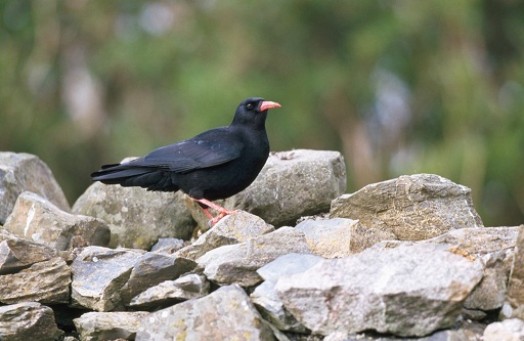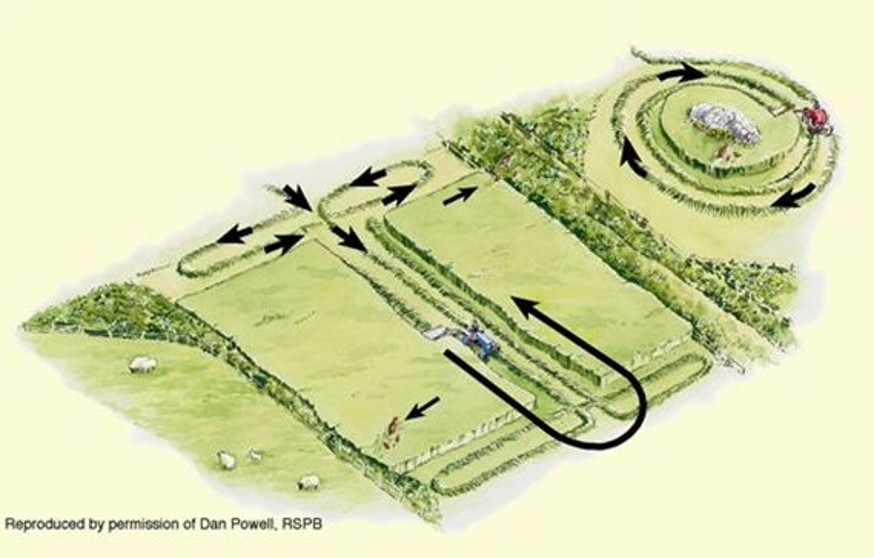Supporting guidance for Chough Grazing Management
Date published: 3 October, 2023
For recent changes to this guidance, please see the bottom of the page.
Introduction

Choughs are part of the crow family but with much more specialised habitat requirements than their near relations such as carrion crows, rooks and magpies.
To survive and breed successfully, chough need:
- nesting habitat on cliffs and in abandoned buildings
- access to year-round short vegetation and livestock dung in which to find their insect food
- silage / hay aftermath in which to find their insect food during chick-rearing
The Chough Grazing Management option provides access to short vegetation required for chough feeding by supporting grazing and, if a silage cut is taken, provides silage aftermath for chick-rearing.
Year-round grazing will help prevent a build-up of matted vegetation, allowing chough access to the soil. It also provides plenty of dung!
Choughs prefer to forage in short-grazed, free-draining grassland and silage aftermath of between one and 10 centimetres in height, as this allows them access to the soil insects on which they feed. If this option is selected for species rich grassland or machair, grazing levels should allow plants to flower and set seed. This could include very low grazing levels during flowering season.
Hay and silage crops are especially beneficial where cutting dates are staggered to extend the period when a freshly-cut crop is available. Where possible, you can also apply an early cut under the Chough Grazing Management option in combination with a later cut under the Chough Mown Grassland option to maximise the benefit to chough.
This option encourages an early cut, with follow-on grazing to provide areas of short grass.
To work out the area eligible to claim, eliminate any parts of the field ineligible for the Basic Payment Scheme, and eliminate areas of tall vegetation (other than hay / silage) that won’t be grazed short under the adopted grazing regime. Only show your eligible ground on the management map.
Where to locate your chough grazing management
To give best results fields should be close to communal roosts and nest sites traditionally used by family groups and fledglings.
In silage aftermath chough are looking for the leatherjacket larvae – a soil insect. These have been found to be more abundant in fields:
- closer to the sea – west coast Atlantic
- with a south easterly aspect
- that have been cut for silage within the past three years
- have had organic fertiliser (inorganic fertilisers should not be used on fields entered into this option) applied in the last three years
Wildlife-friendly mowing
There is a chance that chosen fields will also contain ground-nesting birds. Mowing can destroy nests and kill chicks that are unable to fly. Mowing for this option should be carried out in a wildlife-friendly manner.
Unless there is longer vegetation immediately adjacent to the field that you have been mowing towards then, if possible, leave a two metre uncut strip for the birds to escape into.

How to increase the success of this option
This option works best when combined with other options that provide feeding and safe nesting sites for chough. This could include the Chough Mown Grassland option and the Creation of Chough Nest Shelter capital item.
It is very important for the effectiveness of this option that Avermectin-based drugs are not used on stock, particularly at chough breeding and chick-rearing times. Chough rely heavily on dung insects for feeding and these drugs reduce the number of insects within the dung. Use of these drugs must be at the recommendation of a vet and with NatureScot approval.
In order to increase food availability for chicks it is also important that there is a presence of dung for as long and sustained a period as possible. This allows new dung to be colonised by insects that are already present in older dung close by.
Further information
Additional information on Avermectin-based drugs is available from NatureScot.
Recent changes
| Section | Change |
|---|---|
| Introduction | Revision stating that Choughs prefer to forage in grassland and silage aftermath of between one and 10 centimetres in height instead of one and 13 centimetres |
Previous versions
Download guidance
Click 'Download this page' to create a printer-friendly version of this guidance that you can save or print.
